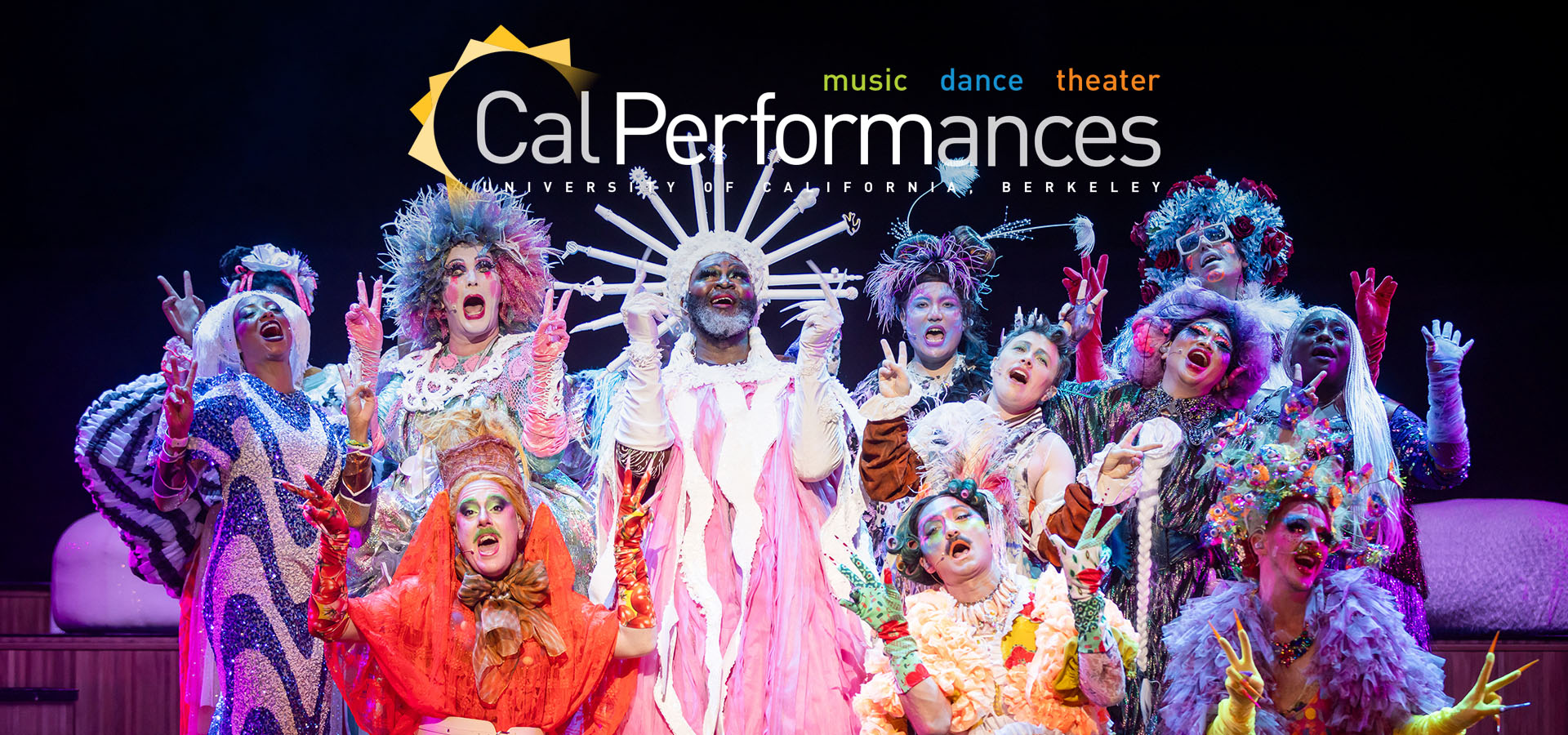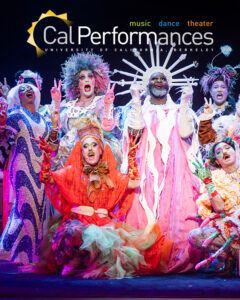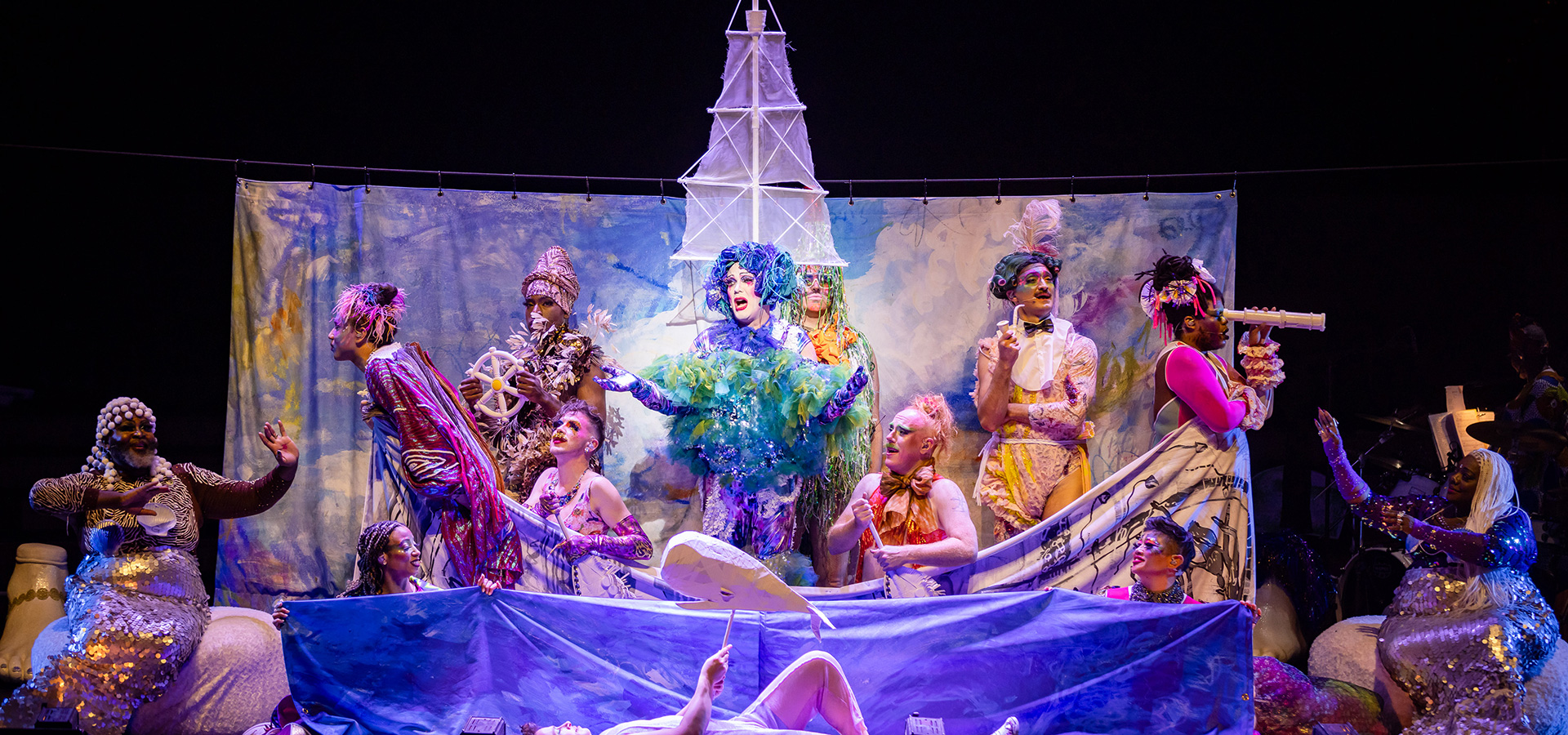Taylor Mac & Matt Ray’s Bark of Millions
A Parade Trance Extravaganza for the Living Library of the Deviant Theme
Friday, and Saturday, February 23–24, 2024, 7pm
Sunday, February 25, 2024, 3pm
Zellerbach Hall
Leadership support for LGBTQ+ programming at Cal Performances is provided by Michael P. N. A. Hormel.
Cal Performances is committed to fostering a welcoming, inclusive, and safe environment for all—one that honors our venues as places of respite, openness, and respect. Please see the Community Agreements section on our Policies page for more information.
Run time for this performance is approximately four hours and 15 minutes. Audience members are invited to leave and return to the theater at their discretion.
From the Executive and Artistic Director
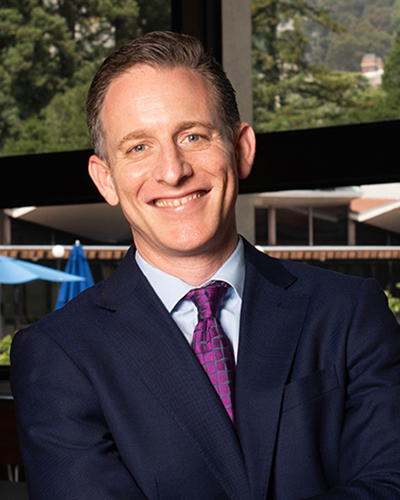
I’m so pleased to welcome you back to campus as we move into the second half of our extraordinary 2023–24 season. There are far too many highlights this month for me to mention each and every one, but I can’t help but single out a few standout events. Of course, any visit by the legendary soprano Renée Fleming is worthy of attention, and this month’s Zellerbach Hall appearance is no exception, coming, as it does, hot on the heels of her receiving the prestigious Kennedy Center Honor for lifetime artistic achievement in December. For dance, you won’t want to miss a dazzling double-bill pairing the late Pina Bausch’s iconic The Rite of Spring with common ground[s], a new duet co-created and performed by septuagenarians Germaine Acogny, known as the “mother of African contemporary dance,” and Malou Airaudo, a longtime dancer with the Tanztheater Wuppertal Pina Bausch. Featuring more than 30 dancers from 14 African countries assembled through a collaboration with Germany’s Pina Bausch Foundation, Senegal’s École des Sables, and the UK’s Sadler’s Wells theater, this program is the type of large-scale and ambitious artistic collaboration that has long defined Cal Performances. And finally, we’re tremendously excited about Taylor Mac & Matt Ray’s upcoming Bark of Millions (see page 6 for more details), an epic “parade trance extravaganza” that celebrates queerness in all its facets and the power of individuality and human connection to push boundaries and bring bold and fresh perspectives to our stage.
As spring approaches, we will continue to invest in ongoing relationships with established and acclaimed artistic partners, with upcoming projects including the renewal of a multi-season residency by The Joffrey Ballet, which this year will present its first full-length narrative ballet, Anna Karenina, at Zellerbach Hall. And I’m especially pleased that in March, the renowned pianist Mitsuko Uchida will join us as Artist in Residence for two special concerts as well as additional opportunities for the campus and wider Bay Area community to engage with her singular artistry.
An ongoing focus of the season is our multi-dimensional Illuminations programming, which once again connects the work of world-class artists to the intellectual life and scholarship at UC Berkeley via performances and public programs investigating a pressing theme—this season, “Individual & Community.” Concepts of “individual” and “community” have been at the forefront of public discourse in recent years, with new questions emerging as to how we can best nurture a sense of community and how the groups we associate with impact our own sense of self. Given our fast-evolving social landscape, how can we retain and celebrate the traits that make each of us unique, while still thriving in a world that demands cooperation and collaboration? With the performing arts serving as our guide and compass, we will explore the tensions that come into play when balancing the interests of the individual with those of the group.
Finally, I want to mention a major new venture coming up next season, the Maria Manetti Shrem and Elizabeth Segerstrom California Orchestra Residency, when Cal Performances and the Philharmonic Society of Orange County will bring the world renowned Vienna Philharmonic and conductor Yannick Nézet-Séguin to California during spring 2025. Made possible by philanthropists Maria Manetti Shrem and Elizabeth Segerstrom, three performances at Zellerbach Hall (March 5–7) will be followed by two in Orange County (March 9 and 11) at the Renée and Henry Segerstrom Concert Hall. Programs will feature works by Mozart, Schubert, Dvořák, Mahler, and Richard Strauss, with acclaimed pianist Yefim Bronfman set to join the orchestra for a Beethoven concerto appearance. Exact programming will be announced shortly, and on-sale dates will be provided in April, when Cal Performances’ 2024–25 season is announced to the general public.
Again, welcome to Cal Performances! We’re delighted to join together, celebrating the very best in live music, dance, and theater.
Jeremy Geffen
Executive and Artistic Director, Cal Performances
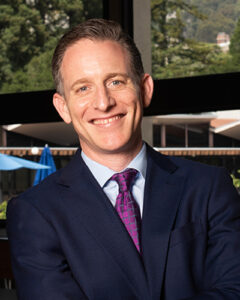 I’m so pleased to welcome you back to campus as we move into the second half of our extraordinary 2023–24 season. There are far too many highlights this month for me to mention each and every one, but I can’t help but single out a few standout events. Of course, any visit by the legendary soprano Renée Fleming is worthy of attention, and this month’s Zellerbach Hall appearance is no exception, coming, as it does, hot on the heels of her receiving the prestigious Kennedy Center Honor for lifetime artistic achievement in December. For dance, you won’t want to miss a dazzling double-bill pairing the late Pina Bausch’s iconic The Rite of Spring with common ground[s], a new duet co-created and performed by septuagenarians Germaine Acogny, known as the “mother of African contemporary dance,” and Malou Airaudo, a longtime dancer with the Tanztheater Wuppertal Pina Bausch. Featuring more than 30 dancers from 14 African countries assembled through a collaboration with Germany’s Pina Bausch Foundation, Senegal’s École des Sables, and the UK’s Sadler’s Wells theater, this program is the type of large-scale and ambitious artistic collaboration that has long defined Cal Performances. And finally, we’re tremendously excited about Taylor Mac & Matt Ray’s upcoming Bark of Millions (see page 6 for more details), an epic “parade trance extravaganza” that celebrates queerness in all its facets and the power of individuality and human connection to push boundaries and bring bold and fresh perspectives to our stage.
I’m so pleased to welcome you back to campus as we move into the second half of our extraordinary 2023–24 season. There are far too many highlights this month for me to mention each and every one, but I can’t help but single out a few standout events. Of course, any visit by the legendary soprano Renée Fleming is worthy of attention, and this month’s Zellerbach Hall appearance is no exception, coming, as it does, hot on the heels of her receiving the prestigious Kennedy Center Honor for lifetime artistic achievement in December. For dance, you won’t want to miss a dazzling double-bill pairing the late Pina Bausch’s iconic The Rite of Spring with common ground[s], a new duet co-created and performed by septuagenarians Germaine Acogny, known as the “mother of African contemporary dance,” and Malou Airaudo, a longtime dancer with the Tanztheater Wuppertal Pina Bausch. Featuring more than 30 dancers from 14 African countries assembled through a collaboration with Germany’s Pina Bausch Foundation, Senegal’s École des Sables, and the UK’s Sadler’s Wells theater, this program is the type of large-scale and ambitious artistic collaboration that has long defined Cal Performances. And finally, we’re tremendously excited about Taylor Mac & Matt Ray’s upcoming Bark of Millions (see page 6 for more details), an epic “parade trance extravaganza” that celebrates queerness in all its facets and the power of individuality and human connection to push boundaries and bring bold and fresh perspectives to our stage.
As spring approaches, we will continue to invest in ongoing relationships with established and acclaimed artistic partners, with upcoming projects including the renewal of a multi-season residency by The Joffrey Ballet, which this year will present its first full-length narrative ballet, Anna Karenina, at Zellerbach Hall. And I’m especially pleased that in March, the renowned pianist Mitsuko Uchida will join us as Artist in Residence for two special concerts as well as additional opportunities for the campus and wider Bay Area community to engage with her singular artistry.
An ongoing focus of the season is our multi-dimensional Illuminations programming, which once again connects the work of world-class artists to the intellectual life and scholarship at UC Berkeley via performances and public programs investigating a pressing theme—this season, “Individual & Community.” Concepts of “individual” and “community” have been at the forefront of public discourse in recent years, with new questions emerging as to how we can best nurture a sense of community and how the groups we associate with impact our own sense of self. Given our fast-evolving social landscape, how can we retain and celebrate the traits that make each of us unique, while still thriving in a world that demands cooperation and collaboration? With the performing arts serving as our guide and compass, we will explore the tensions that come into play when balancing the interests of the individual with those of the group.
Finally, I want to mention a major new venture coming up next season, the Maria Manetti Shrem and Elizabeth Segerstrom California Orchestra Residency, when Cal Performances and the Philharmonic Society of Orange County will bring the world renowned Vienna Philharmonic and conductor Yannick Nézet-Séguin to California during spring 2025. Made possible by philanthropists Maria Manetti Shrem and Elizabeth Segerstrom, three performances at Zellerbach Hall (March 5–7) will be followed by two in Orange County (March 9 and 11) at the Renée and Henry Segerstrom Concert Hall. Programs will feature works by Mozart, Schubert, Dvořák, Mahler, and Richard Strauss, with acclaimed pianist Yefim Bronfman set to join the orchestra for a Beethoven concerto appearance. Exact programming will be announced shortly, and on-sale dates will be provided in April, when Cal Performances’ 2024–25 season is announced to the general public.
Again, welcome to Cal Performances! We’re delighted to join together, celebrating the very best in live music, dance, and theater.
Jeremy Geffen
Executive and Artistic Director, Cal Performances
A Note from Taylor Mac
Increasingly I find myself interested in mystery. Especially when it comes to queerness (and art). I want to wonder on queerness rather than decide and tell others what it is. I’d like to inspire the same in our audiences. Yet, we must accept a certain amount of reality. Marketing teams will need to attract the audience, press will want to know how to describe it, critics will define it if you don’t, and some people (I’m often one of those people) will want breadcrumbs called a program note. And, if we’re to believe James Baldwin, “The root function of language is to control the universe by describing it” (though this is from someone who didn’t live long enough to hear about the mycorrhizal network). In the end, I love having an audience, try to think of critics as part of the collaborative, and am prone to give Baldwin the benefit of the doubt. So I’ve agreed to control the universe a little. Or at least, define. Give it an entry point.
So what is this you’re about to see (have seen, are thinking of seeing)? What I think I know (though even this might not be true) is: it’s freaking queer. What I mean by that is, this is an artwork that longs for you to wonder on it, in it, and with it. It seems that that’s what queerness, gummed up in systems so long defined by adherence to majorities, also longs for.
What also seems true is, much like a queer, this is a hybrid work. You could think of it as an opera-concert-song-cycle-musical-performance-art-piece-play. It’s certainly structured like all of those things squished together. Maybe this will help: its subtitle is “A Parade Trance Extravaganza for the Living Library of the Deviant Theme”. I’ve never seen a parade trance extravaganza for the living library of the deviant theme, so I’ve no context to measure our success. Regardless, the work is more about the stretching towards than the realization of. And, though we’ve started performing the work, it isn’t finished. I’m not sure it ever will be. It certainly wasn’t intended to have an end date. The intention is for it to grow with each passing year. We started with 55 songs (one for every year since the world’s first Pride Parade). Something you heard/will hear in the show (but in case you miss it) is that each song in the piece was inspired by a different queer person from world history. Some you’ll know. Some you won’t. Sometimes we tell you the names. Sometimes we don’t. The intention is not to teach you about them, represent them, honor them (some are real assholes), or even acknowledge their existence. The intention is to ground our considerations (and songwriting) in queerness.
Here’s something that terrifies me about the work (and also makes me laugh): there’s an unintentional cult-like…motif? It’s something that happens when you get a bunch of queers on a stage and have them harmonize. They seem like a cult. Perhaps more so because of the watchers’/listeners’ upbringing (or flight/fight response) than anything that’s actually happening on the stage. Please know, if it seems like we’re praising rather than wondering…then that might be because you’ve most likely never seen a group of queer people sing songs inspired by queer people for four hours. So the only context you have is…church.
Though, to be fair, we do start with one of the first gods in human history, Atum (or Ra, the ancient Egyptian Sun God) and end (nearly) with Antinous (the lover of the emperor Hadrian, who grieved over Antinous’ death to such a degree that he created a religion named after him). So the whole work is framed by songs inspired by queers who made queer gods. Atum was gender queer. They made themself, if we’re to believe the myth, by uttering their name. What’s more queer than that? Then they birthed humans by crying them into existence. The thing that gives me life, in that consideration, are not the tears themselves, but the fact that a culture defined tears as a form of creation rather than as a form of shedding. All the gods that humans have made seem to pour metaphorical fluids out of themselves to create: tears, blood, ejaculate.
Similarly, what I think I know is, Matt Ray and I (and the entire collaborative and queers of the world) have been storing up our history, pain, erasure, and love, love, love, for what seems like millenniums. In that sense, we’re not queer historians, teachers, or worshippers of Antinous, Ra, or even Kate Bornstein. We’re lovers rubbing out a river Nile. If that rubbing out feels like some form of conversion, well, that’s your kink.
Plus, you’re not entirely wrong. The hope is that we’ll make you a little more queer than when you entered the theater. The hope is, as a result of making you a little more queer, you’ll do the same to others, and then we all won’t have to watch our backs as much. But is that really the show? The tongue-in-cheek, yes-and-no version, yes. Or rather, the version where queerness is considered in a pouring out of song, yes please.
xo
—Taylor Mac
A Note from Matt Ray
Taylor Mac and I share a goal as artists to make work that builds community over a long arc. We continuously reach towards this goal by fostering and nurturing long-term relationships with artistic collaborators, musicians, singers, actors, creatives, and audiences. My dream is that as you witness our family on stage, you feel yourselves leaning in towards us and joining our world of beauty, hope, remembrance, sharing, darkness, light, and action. As we sing out our history, it is not just a calling back but an urging forward, together.
—Matt Ray
A Note on the Title
To the ancient Egyptians, creation is a process of unfurling with the undivided. The first god, Atum (also the first genderqueer) created themself by uttering their name in an infinite expanse of darkness and directionless water called Nun. Atum (also called Temu, Tem, Ra, depending on the point in their rebirthing process) then turned into a Bennu bird and, similar to a phoenix, would burst into flames, then be reborn each day. In this action the earth was created as a reflection of the heavens. At some point the eye of Atum separated and wandered off on its own and in a struggle to return it, it cried tears, which created humans. Years later, in Atum’s senility, humans plotted against their creator, which separated the heavens from earth and sent Atum into the heavens, leaving humans below (presumably no longer a reflection). This separation creates the Bark of Millions. It is sometimes depicted as a boat version of the sun (representing Atum) and sometimes depicted as a vessel Atum captains, while pulling the sun behind it. Because Atum is no longer with us, they must bring the sun to us. Day after day, year after year, this bark sails around the heavens bringing light to the earth. Each evening, Atum on their Bark (or as the bark) does battle against the serpent Apep (the aspect of chaos), who tries to bring darkness to the planet. Each morning, Atum is victorious and is able to bring themself back to us (the millions in the Bark of Millions refers to the years of battles and victories).
Bark of Millions Fan Deck
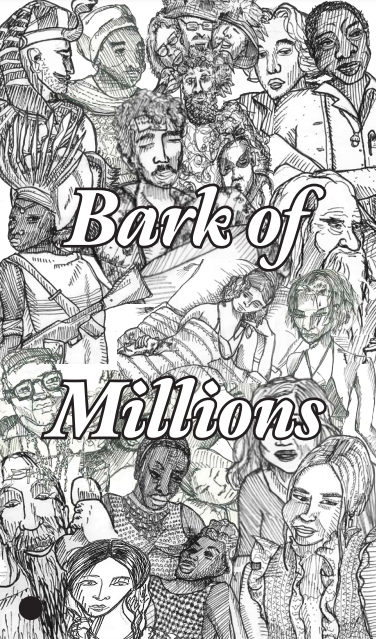
Bark of Millions is composed of 55 songs—each inspired by a queer person from world history. Audience members are invited to further engage with the music and lyrics in printed form with a limited-edition fan deck created by artist Sister Sylvester in response to the work. Bark of Millions fan decks will be available for purchase at Zellerbach Hall for $20.
A complimentary digital version is available on the Bark of Millions website.
Bark of Millions is a work that asks for the audience’s attention and consideration of the action on stage, and we ask that you refrain from following along on your phone throughout the performance. Please peruse this deck before or after the performance.


